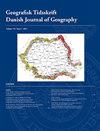基于景观变化研究和激光雷达揭示第一次世界大战弹孔景观的保存
IF 1.1
4区 社会学
Q4 ENVIRONMENTAL STUDIES
Geografisk Tidsskrift-Danish Journal of Geography
Pub Date : 2018-12-13
DOI:10.1080/00167223.2018.1556105
引用次数: 5
摘要
第一次世界大战(WWI;由于现代和快速变化的景观,1914-1918)正在迅速消失。因此,有必要监测标志着我们过去的景观遗迹。这项研究考察了炮击造成的洼地。这些弹孔至今仍然存在,是西线长达4年的僵局中军事影响的最后遗迹之一。迄今为止,在景观研究中,贝壳洞景观一直被忽视,很少有人关注这些贝壳洞在当今微地形中缺失或存在的原因。本文旨在通过在景观尺度上使用数字跨学科技术来确定这些原因:光探测和测距(LiDAR)可以深入了解当今弹孔的存在,景观地图显示了过去一个世纪土地利用/土地覆盖的演变,以及代表1918年情况的弹孔密度图。结果表明,第一次世界大战的弹孔景观至今仍大量存在,而在其消失的地方,从过去到现在的土地利用/土地覆盖变化和耕地强度水平之间存在直接联系。为了实现第一次世界大战遗产的可持续管理,这些发现是不可或缺的。本文章由计算机程序翻译,如有差异,请以英文原文为准。
Revealing the preservation of First World War shell hole landscapes based on a landscape change study and LiDAR
ABSTRACT The surface scars of the First World War (WWI; 1914–1918) are rapidly disappearing due to modern and fast changing landscapes. Therefore, there is a need to monitor landscape relicts that mark our past. This study examines depressions caused by shelling. These shell holes are still present today and are one of the last remains of the military impact during the 4 years long stalemate on the Western Front. Shell hole landscapes are until now overlooked in landscape research and little attention is given to the causes behind the absence or presence of these shell holes in the present-day micro-topography. This paper aims to identify these causes by using digital interdisciplinary techniques on a landscape scale: Light detection and ranging (LiDAR) giving insights into the presence of the shell holes today, landscape maps indicating the evolution of land use/land cover in the past century and a shell hole density map representing the situation of 1918. Results revealed that the WWI shell hole landscape is still abundantly present today, and where it has disappeared, a direct link was found to land use/land cover transformations and the intensity level of cultivated fields from past to present. To work towards a sustainable management of WWI heritage, these findings are indispensable.
求助全文
通过发布文献求助,成功后即可免费获取论文全文。
去求助
来源期刊
CiteScore
5.20
自引率
0.00%
发文量
5
期刊介绍:
DJG is an interdisciplinary, international journal that publishes peer reviewed research articles on all aspects of geography. Coverage includes such topics as human geography, physical geography, human-environment interactions, Earth Observation, and Geographical Information Science. DJG also welcomes articles which address geographical perspectives of e.g. environmental studies, development studies, planning, landscape ecology and sustainability science. In addition to full-length papers, DJG publishes research notes. The journal has two annual issues. Authors from all parts of the world working within geography or related fields are invited to publish their research in the journal.

 求助内容:
求助内容: 应助结果提醒方式:
应助结果提醒方式:


